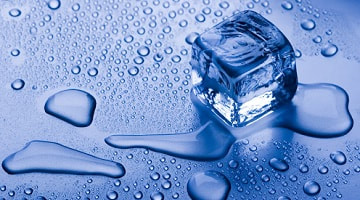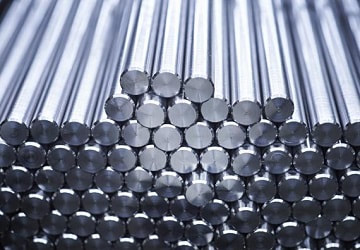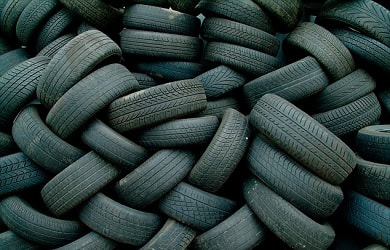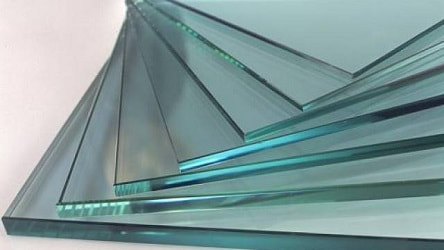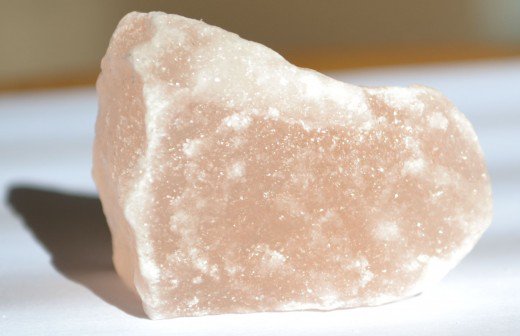|
Solids are strange stuff. Although all of them consists of interlocking particles, some of them are malleable, while others are not. Some of them are naturally transparent, and others opaque. Some will readily dissolve in a liquid, while other are stubbornly stay as they are.
In this article, we explore the reasons why solids are as they are...weird. |
"Most students treat knowledge as a liquid to be swallowed rather than as a solid to be chewed, and then wonder why it provides so little nourishment."
Sydney J. Harris, journalist and author, Chicago Sun-Times
A solid is like a liquid in that particles are in contact with each other. Solids are unlike liquids in that the intermolecular forces are strong enough to hold the particles in place. At low enough temperatures, all substances are solids (helium is the lone exception), but the temperature at which the solid state becomes the stable phase varies widely among substances, from 20 K (−253°C) for hydrogen to over 3,900 K (3,600°C) for carbon.
The solid phase has several characteristics. First, solids maintain their shape. They do not fill their entire containers like gases do, and they do not adopt the shape of their containers like liquids do. They cannot be easily compressed like gases can, and they have relatively high densities.
Solids may also demonstrate a variety of properties. For example, many metals can be beaten into thin sheets or drawn into wires, while compounds such as NaCl will shatter if they are struck. Some metals, such as sodium and potassium, are rather soft, while others, such as diamond, are very hard and can easily scratch other substances. Appearances differ as well: most metals are shiny and silvery, but sulfur (a nonmetal) is yellow, and ionic compounds can take on a rainbow of colors. Solid metals conduct electricity and heat, while ionic solids do not. Many solids are opaque, but some are transparent. Some dissolve in water, but some do not.
The solid phase has several characteristics. First, solids maintain their shape. They do not fill their entire containers like gases do, and they do not adopt the shape of their containers like liquids do. They cannot be easily compressed like gases can, and they have relatively high densities.
Solids may also demonstrate a variety of properties. For example, many metals can be beaten into thin sheets or drawn into wires, while compounds such as NaCl will shatter if they are struck. Some metals, such as sodium and potassium, are rather soft, while others, such as diamond, are very hard and can easily scratch other substances. Appearances differ as well: most metals are shiny and silvery, but sulfur (a nonmetal) is yellow, and ionic compounds can take on a rainbow of colors. Solid metals conduct electricity and heat, while ionic solids do not. Many solids are opaque, but some are transparent. Some dissolve in water, but some do not.
Metal, rubber, and glass. Each composed of different elements, have different molecular structures, and different properties.
Solids can have a wide variety of physical properties because there are different types of solids. Here we will review the different types of solids and the bonding that gives them their properties.
First, we must distinguish between two general types of solids. An amorphous solid is a solid with no long-term structure or repetition. Examples include glass and many plastics, both of which are composed of long chains of molecules with no order from one molecule to the next. A crystalline solid is a solid that has a regular, repeating three-dimensional structure. A crystal of NaCl is one example: at the atomic level, NaCl is composed of a regular three-dimensional array of Na+ ions and Cl− ions.
First, we must distinguish between two general types of solids. An amorphous solid is a solid with no long-term structure or repetition. Examples include glass and many plastics, both of which are composed of long chains of molecules with no order from one molecule to the next. A crystalline solid is a solid that has a regular, repeating three-dimensional structure. A crystal of NaCl is one example: at the atomic level, NaCl is composed of a regular three-dimensional array of Na+ ions and Cl− ions.
Clay is an amorphous solid, while this lump of rock salt is a crystalline solid
There is only one type of amorphous solid. However, there are several different types of crystalline solids, depending on the identity of the units that compose the crystal.
An ionic solid is a crystalline solid composed of ions (even if the ions are polyatomic). NaCl is an example of an ionic solid. The Na+ ions and Cl− ions alternate in three dimensions, repeating a pattern that goes on throughout the sample. The ions are held together by the attraction of opposite charges—a very strong force. Hence most ionic solids have relatively high melting points; for example, the melting point of NaCl is 801°C. Ionic solids are typically very brittle. To break them, the very strong ionic attractions need to be broken; a displacement of only about 1 × 10−10 m will move ions next to ions of the same charge, which results in repulsion. Ionic solids do not conduct electricity in their solid state; however, in the liquid state and when dissolved in some solvent, they do conduct electricity. This fact originally promoted the idea that some substances exist as ionic particles.
A molecular solid is a crystalline solid whose components are covalently bonded molecules. Many molecular substances, especially when carefully solidified from the liquid state, form solids where the molecules line up with a regular fashion similar to an ionic crystal, but they are composed of molecules instead of ions. Because the intermolecular forces between molecules are typically less strong than in ionic solids, molecular solids typically melt at lower temperatures and are softer than ionic solids. Ice is an example of a molecular solid. In the solid state, the molecules line up in a regular pattern. Some very large molecules, such as biological molecules, will form crystals only if they are very carefully solidified from the liquid state or, more usually, from a dissolved state; otherwise, they will form amorphous solids.
An ionic solid is a crystalline solid composed of ions (even if the ions are polyatomic). NaCl is an example of an ionic solid. The Na+ ions and Cl− ions alternate in three dimensions, repeating a pattern that goes on throughout the sample. The ions are held together by the attraction of opposite charges—a very strong force. Hence most ionic solids have relatively high melting points; for example, the melting point of NaCl is 801°C. Ionic solids are typically very brittle. To break them, the very strong ionic attractions need to be broken; a displacement of only about 1 × 10−10 m will move ions next to ions of the same charge, which results in repulsion. Ionic solids do not conduct electricity in their solid state; however, in the liquid state and when dissolved in some solvent, they do conduct electricity. This fact originally promoted the idea that some substances exist as ionic particles.
A molecular solid is a crystalline solid whose components are covalently bonded molecules. Many molecular substances, especially when carefully solidified from the liquid state, form solids where the molecules line up with a regular fashion similar to an ionic crystal, but they are composed of molecules instead of ions. Because the intermolecular forces between molecules are typically less strong than in ionic solids, molecular solids typically melt at lower temperatures and are softer than ionic solids. Ice is an example of a molecular solid. In the solid state, the molecules line up in a regular pattern. Some very large molecules, such as biological molecules, will form crystals only if they are very carefully solidified from the liquid state or, more usually, from a dissolved state; otherwise, they will form amorphous solids.
Some solids are composed of atoms of one or more elements that are covalently bonded together in a seemingly never-ending fashion. Such solids are called covalent network solids. Each piece of the substance is essentially one huge molecule, as the covalent bonding in the crystal extends throughout the entire crystal. The two most commonly known covalent network solids are carbon in its diamond form and silicon dioxide (SiO2). Generally, covalent network solids are poor conductors of electricity, although their ability to conduct heat is variable: diamond is one of the most thermally conductive substances known, while SiO2 is about 100 times less thermally conductive. Most covalent network solids are very hard, as exemplified by diamond, which is the hardest known substance. Covalent network solids have high melting points by virtue of their network of covalent bonds, all of which would have to be broken for them to transform into a liquid. Indeed, covalent network solids are among the highest-melting substances known: the melting point of diamond is over 3,500°C, while the melting point of SiO2 is around 1,650°C. These characteristics are explained by the network of covalent bonds throughout the sample.
Diamond is a covalent network solid, with each C atom making four covalent bonds to four other C atoms. A diamond is essentially one huge molecule.
A metallic solid is a solid with the characteristic properties of a metal: shiny and silvery in color and a good conductor of heat and electricity. A metallic solid can also be hammered into sheets and pulled into wires. A metallic solid exhibits metallic bonding, a type of intermolecular interaction caused by the sharing of the s valence electrons by all atoms in the sample. It is the sharing of these valence electrons that explains the ability of metals to conduct electricity and heat well. It is also relatively easy for metals to lose these valence electrons, which explains why metallic elements usually form cations when they make compounds.
Diamond is a covalent network solid, with each C atom making four covalent bonds to four other C atoms. A diamond is essentially one huge molecule.
A metallic solid is a solid with the characteristic properties of a metal: shiny and silvery in color and a good conductor of heat and electricity. A metallic solid can also be hammered into sheets and pulled into wires. A metallic solid exhibits metallic bonding, a type of intermolecular interaction caused by the sharing of the s valence electrons by all atoms in the sample. It is the sharing of these valence electrons that explains the ability of metals to conduct electricity and heat well. It is also relatively easy for metals to lose these valence electrons, which explains why metallic elements usually form cations when they make compounds.
Ponder this
Considering the subatomic nature of transparency, can a chemically pure solid transition between transparency and opacity?
Is it possible for malleable solids to retain their malleability even at absolute zero?
Discuss
Look around your classroom and find as many types of solids there are. Classify them into amorphous and crystalline, as well as ionic and molecular solids. Find those that are molecularly and elementally pure (e.g. wood and carbon in a pencil). Discuss how they may change their nature through chemical processes, or stop becoming solids altogether.
Further readings
Solids, for a more detailed coverage on how weird chemistry can be.
What makes glass transparent?, probably the most oblivious question us all.
Amorphous solid, an amorphous solid is a solid that lacks the long-range order that is characteristic of a crystal.
Crystalline solid, crystalline solid is a solid material whose constituents are arranged in a highly ordered structure, forming a crystal lattice.

